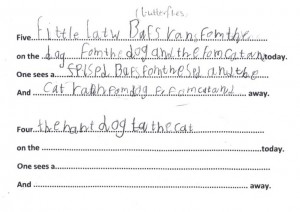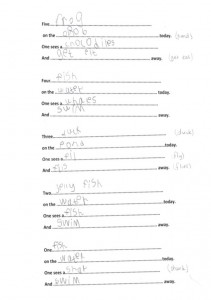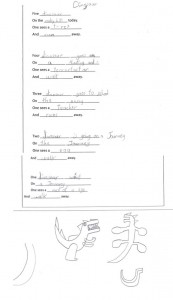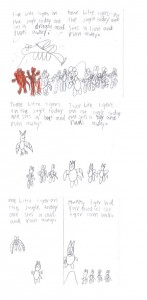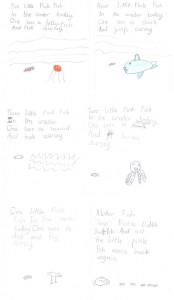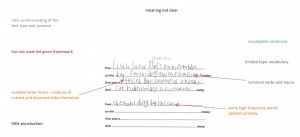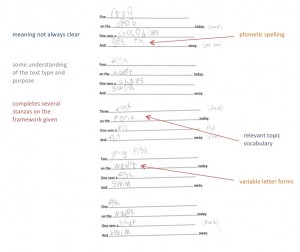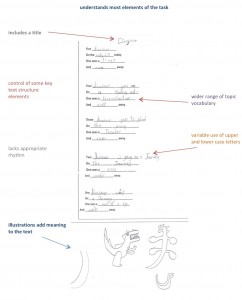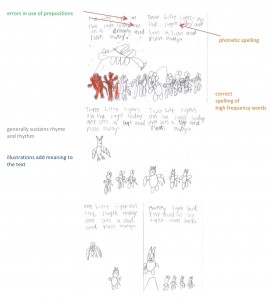8. Story innovation
Please click on the toggles below to navigate through information on this assessment task and reveal the links for downloading task materials.
Task details |
|
| Name of writing assessment task | Story innovation |
| EAL curriculum level range | A1, A2, BL, B1, B2 |
| Text orientation | Imaginative |
| Task type | Text completion/extended response |
Task specification |
|
| Purpose | To assess students’ ability to innovate on a simple, repetitive story/poem. |
| Description | Students innovate on a story, using a framework or sentence starters taken from a repetitive published text. |
| Assumed knowledge and description |
|
Learning/teaching context |
|
| Language centre/mainstream class | Small group |
| Subject/key curriculum objectives, outcomes | English |
| Topic/teaching unit | |
| Assessment conditions |
|
| Notes |
|
Task implementation |
|
| STAGE | ACTION STEPS |
| Pre-assessment activity |
|
| Assessment activity |
|
| Post-assessment activity |
|
- TEAL Writing Task 8 – unmarked criteria sheet [PDF]
- TEAL Writing Task 8 – unmarked criteria sheet [Word]
An explanation of the purpose, nature and use of criteria sheets is available at 4. Using the assessment criteria.
Purpose and value of task
This task assesses students’ ability to innovate on a well-known repetitive, rhythmic, well-illustrated imaginative story they are familiar with, using their own words. The task gives teachers the opportunity to watch students as they write and to observe the strategies and resources they use to construct their texts. This kind of task is a common classroom task, where students listen to stories and then do a range of early reading and writing tasks based on them. The task may be suitable for younger students at CL and C1 as long as the chosen text is age-appropriate.
Contextual information
The students were all very familiar with the story from listening to it several times, and talking about what happened in it. They could read it in with their teacher. They undertook a range of activities including brain storming possible vocabulary, as well as activities to identify rhyming words.
Commentary
It is clear from the samples that the students are still at early stages of writing in English. Apart from the student in Sample 1 they understand the need to complete the sentences in the framework they were provided with. Some older students were able to complete their sentences without a framework. Some students did little more than reproduce the text from the story, but others were able to write their own text. Students have provided some imaginative examples. Their stage of oral English language development will also affect what they are able to write, and some students were able to express more sophisticated ideas than others. Older students with more advanced understanding and skills in writing were able to provide more text. At this stage and age students will find it challenging to maintain rhythm and rhyme in their own innovations, but most of the students show clear attempts to do so.
Students also varied in their attempts to maintain the third-person singular verb agreement in sentences such as Run(s) away, Swim(s) away. Students may pick up on the grammatical patterns to correctly form this in a modelled activity but it is not likely to correctly be used in other contexts.
The students employed a range of strategies to write their texts, including attempts at spelling using their developing understanding of the sound-symbol relationships of English. Some students seemed to prefer to attempt spelling words their own way, while others sought out other strategies such as memorising or copying words.
Year level: 1
In this sample the student has not understood the need to read and follow the framework given. The student has written a repetitive story, but it is not always comprehensible. The student repeats the formulaic phrase from the throughout the text.
The spelling shows a mixture of common words spelt correctly, cat, dog, the, and, and invented spelling which show a developing understanding of sound-letter relationships in English, fom (from), Bafs (butterflies), spd (spider?). These words are spelled the same way throughout the text.
Insufficient space is left between words and there is no evidence of punctuation or use of upper case letters for the start of sentences. The handwriting is uneven in size, and some idiosyncratic letter formations are used, for example the letter p does not go below the line.
The marked criteria sheet shows that the student meets some criteria at level 1 of performance.
The student’s language use in this task is consistent with the descriptions of students at Level A1, Victorian Curriculum F-10 EAL.
TEAL Writing Task 8 – criteria sheet – Sample 1
Using this assessment for further learning
Ask the student to reread the text. Scribe the first couple of sentences for the student and reread together. Show the student how spaces have been left between words, and how the new sentences have an upper case letter at the start of the sentence and a full stop at the end.
Ask the student to think of words that could go in the spaces on the template, and scribe these if the student cannot do so.
Year level: 1
In this sample the student has understood the need to follow the framework, and provides words for each ‘space’. The student, although not following the model by using the same kind of animal for the first line of each stanza, still produces plausible sentences. The student provides a verb for the last line in each case. No plural forms are used.
The handwriting is still developing with some idiosyncratic letter formations which do not always ‘sit on the line’. The writing is sized appropriately. The spelling is almost always correct, one of the incorrect words, shar, may be a transcription error.
The marked criteria sheet shows that the student meets most criteria at level 2 of performance.
The student’s language use in this task is consistent with the descriptions of students at Level A1, Victorian Curriculum F-10 EAL.
TEAL Writing Task 8 – criteria sheet – Sample 2
Using this assessment for further learning
- Construct a table such as the following to help the student to notice how plural nouns usually finish with ‘s’.
| One duck | One cat | One ________ | One apple |
| Two ducks | Two cats | Two dogs | Two apples |
| Three ducks | Three _________ | Three dogs | Three apples |
| Four __________ | _______ __________ | Four ___________ | __________ _________ |
| _________ _________ | Five ______________ | __________ ________ | __________ apples |
Read the phrases, including the missing words, while the student points to the correct one. Ask the student to read them and then complete the table. The student may be able to add another noun that follows the same pattern. If appropriate, point out words such as fish do not follow this pattern.
- Using a fresh framework, scribe the student's sentences again as he or she reads them. Ask the student to point out which letters go ‘under the line’, and which ones ‘sit on the line’. The student can practise writing words such as frog, pond, and jelly.
Year level: 3/4
The student gives this sample a heading (including a capital letter), and uses the word dinosaur at the opening of each stanza. Although the student’s writing on the framework does not always conform to the required rhyme and rhythm patterns, the student has used interesting ideas in the innovation.
The student uses a verb in the required place in each stanza, but doesn’t use the plural form of dinosaur. High-frequency words are spelled correctly, and plausible spellings used for some words such as pterodactyl. Upper case letters have been used wrongly in some places.
The marked criteria sheet shows that the student meets criteria at levels 2 and 3 of performance.
The student’s language use in this task is consistent with the descriptions of students at Level B1, Victorian Curriculum F-10 EAL.
TEAL Writing Task 8 – criteria sheet – Sample 3
Using this assessment for further learning
Tap out to the student the rhythm of the original story as you read it, and then tap out the rhythm of the student’s story as he or she reads it. The student may be able to modify the first one or two stanzas to match the rhythm of the original.
Commend the students spelling of pterodactyl, as what they have written really looks very much like it sounds. Explain that this word is a very odd one, and see if he or she can find it in a book. Point out how it has a silent letter. Read the word pterodactyl to the student emphasising the l sound at the end. Point out the l at the end of the word. Read it together.
- Construct a table such as the following to help the student to notice how plural nouns usually finish with ‘s’.
| One duck | One cat | One ________ | One apple |
| Two ducks | Two cats | Two dogs | Two apples |
| Three ducks | Three _________ | Three dogs | Three apples |
| Four __________ | _______ __________ | Four ___________ | __________ _________ |
| _________ _________ | Five ______________ | __________ ________ | __________ apples |
Year level: 3/4
The student has constructed the text without use of a teacher-provided framework, but after a range of activities around the shared text.
Appropriate rhyme and rhythm patterns have been used. The student uses the word on instead of in throughout. The plural form of tiger has been used where necessary. The student uses both run away and runs away, but no other verbs.
A final stanza has been provided. Spelling is mostly correct, and the word jungle, although incorrect, has been spelled the same way in each stanza. The student has used a capital letter and a full stop at the start and end of each stanza, effectively treating each stanza as a sentence.
The student has illustrated the text. Handwriting is generally appropriately sized, but it is not always apparent whether a letter is an upper or lower case letter. There is evidence of planning in the way the text has been placed on the page.
The marked criteria sheet shows that the student meets criteria at levels 2 and 3 of performance.
The student’s language use in this task is consistent with the descriptions of students at Level B2, Victorian Curriculum F-10 EAL.
TEAL Writing Task 8 – criteria sheet – Sample 4
Using this assessment for further learning
Point out to the student that we say in the jungle, not on the jungle. Talk about how we use in in an enclosed situation, such as in a car, in a room, in a house, and that we use in with jungle as it is all around us, like a room or a house. When we use on, such as on a bicycle, on a skateboard, on a chair, we are usually not enclosed, except in the case of a train or aeroplane where on is usually used!
Point out to the student that it is not always easy to tell if he or she is writing an upper or lower case letter. Ask the student to mark where he or she thinks an upper case letter should go, and then to find upper case letters that could be in the wrong place.
Year level: 3/4
The student has produced a neatly written and illustrated text, with correct rhyme and rhythm.
The text is neatly set out, showing evidence of planning. Each line generally starts with an upper case letter, as would a poem. Little Pink Fish always starts with upper case letters, as if it were a name.
This student has not used third-person singular verb agreement in his or her sentences such as Run(s) away, Swim(s) away.
Some self-correction has been done. The words are virtually all spelled correctly. A final stanza has been written.
The marked criteria sheet shows that the student meets most criteria at level 3 of performance.
The student’s language use in this task is consistent with the descriptions of students at Level B2, Victorian Curriculum F-10 EAL.
TEAL Writing Task 8 – criteria sheet – Sample 5
Using this assessment for further learning
Read the student's work back to him or her, while the student follows the text and reads along. Pronounce with emphasis the missing ‘s’ on run, jump, hide, swim and fly, as you read, and see if the student can pick up the discrepancy between what is read and what is on the page. If not, point this out, and ask the student to add the missing ‘s’. Show the student how we can’t just put an ‘s’ on fly, but must spell it flies. Can the student think of other words that follow the same spelling pattern?

